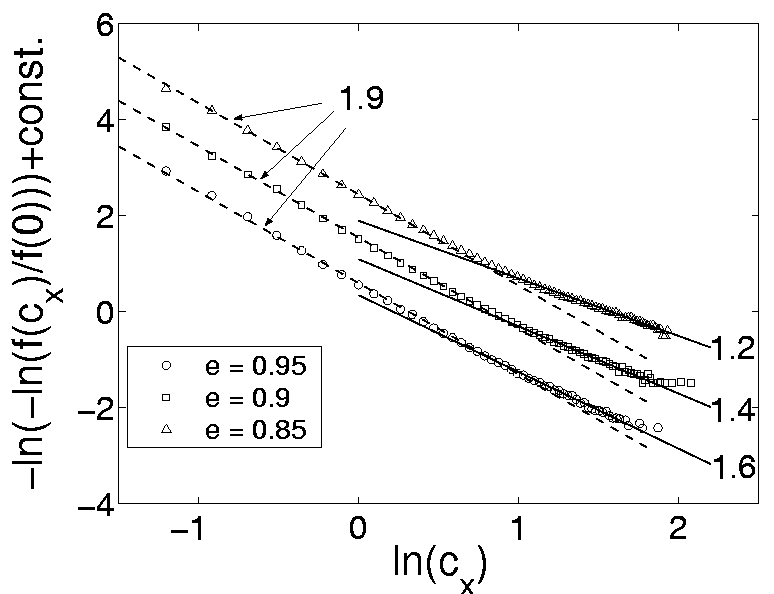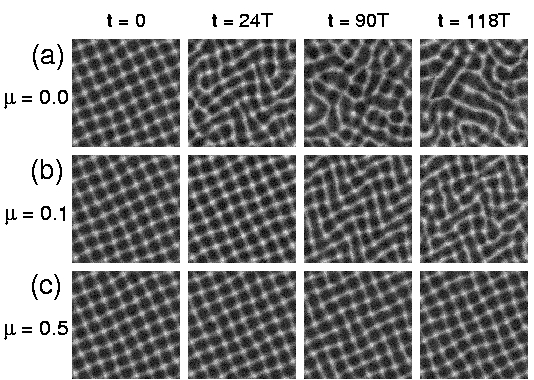 Sung Joon Moon
Sung Joon MoonAssociate Research Scholar
Program in Applied and Computational Mathematics &
Department of Chemical Engineering
Princeton University
Princeton, NJ 08544
phone: 609-258-2977 (or 609-258-0543)
fax: 609-258-021
moon@arnold.princeton.edu
Primary Research Focus
The general
theme of my research lies in modeling and multiscale
simulation of complex systems (not merely "complicated"
systems!), physical, biological, or artificial, using novel methods of
computational mathematics. Currently, I study a few different systems,
particularly those with physical applications and direct experimental
comparisons, including (but not limited to):
(1) fluidized granular materials (collections of macroscopic particles interacting via contacts),
(2) multiphase flows of gas-particle mixtures (multiscale, hybrid simulation of vibrated gas-fluidized beds of fine, cohesive powders), and
(3) modeling and multiscale analysis of synchronization phenomena in biological systems, such as coordinated movement of animal groups.
Additional information about my research can be found below.
(1) fluidized granular materials (collections of macroscopic particles interacting via contacts),
(2) multiphase flows of gas-particle mixtures (multiscale, hybrid simulation of vibrated gas-fluidized beds of fine, cohesive powders), and
(3) modeling and multiscale analysis of synchronization phenomena in biological systems, such as coordinated movement of animal groups.
Additional information about my research can be found below.
Education/Experience
Sep. 1997 - May 2003 Ph. D (physics), Ctr. for Nonlinear Dynamics
& Phys. Dept., The
Univ. of Texas at Austin.
Jul. 1996 - Jun. 1997 Research Assistant, Ctr. for Plasma and Fusion Studies, KAIST, Korea.
May 1994 - Jul. 1996 Republic of Korea Marine Corps (ROKMC).
Mar. 1989 - Feb. 1993 B. Sc. (physics), Phys. Dept., Korea Adv. Inst. of Sci. and Tech. (KAIST), Taejon, Korea.
Mar. 1987 - Feb. 1989 Kyonggi Science High School,Suwon, Korea.
Jul. 1996 - Jun. 1997 Research Assistant, Ctr. for Plasma and Fusion Studies, KAIST, Korea.
May 1994 - Jul. 1996 Republic of Korea Marine Corps (ROKMC).
Mar. 1989 - Feb. 1993 B. Sc. (physics), Phys. Dept., Korea Adv. Inst. of Sci. and Tech. (KAIST), Taejon, Korea.
Mar. 1987 - Feb. 1989 Kyonggi Science High School,Suwon, Korea.
Presentations
YOU'VE MISSED MY TALKS? CLICK HERE
& SEE SOME OF THEM. (coming soon)
Professional
Activities: Referee for
Physical Review Letters, Physical Review E, Europhysics Letters, AIChE J, Fluid Dynamics Research.
Physical Review Letters, Physical Review E, Europhysics Letters, AIChE J, Fluid Dynamics Research.
Research highlights
1. Kink-induced segregation in oscillated granular layers ("the horizontal Brazil-nut effect")
 The Brazil-nut effect is an odd but well-known phenomenon in vibrated
granular mixtures; shaking containers filled with grains of various
sizes will cause the larger grains to rise to the top of the mixture. We
showed that horizontal distribution of large grains can be controlled by
sweeping kinks that spontaneously arise in granular layers for
sufficiently large container accelerations. This phenomenon, now known
as "the horizontal Brazil-nut effect", is
a good way to harvest large particles from a granular mixture (see details).
The Brazil-nut effect is an odd but well-known phenomenon in vibrated
granular mixtures; shaking containers filled with grains of various
sizes will cause the larger grains to rise to the top of the mixture. We
showed that horizontal distribution of large grains can be controlled by
sweeping kinks that spontaneously arise in granular layers for
sufficiently large container accelerations. This phenomenon, now known
as "the horizontal Brazil-nut effect", is
a good way to harvest large particles from a granular mixture (see details). Strongly
agitated grains exhibit behaviors reminiscent of a gas, which is often
referred to as a granular gas. Granular gas is always far from
equilibrium, due to the dissipative nature of the collision. The
deviation from the Maxwell-Boltzmann velocity distribution function at a
nonequilibrium steady or an oscillatory state has been of great interest
in the view point of the kinetic theory (or more generally,
nonequilibrium statistical mechanics). We used a frictional inelastic
hard sphere simulation to demonstrate that the distribution function in
a granular gas, driven by an oscillating plate with high acceleration,
exhibits height-invariance far from
the plate in a large Knudsen number limit. We also looked at high
energy tails for various cases (see details).
Strongly
agitated grains exhibit behaviors reminiscent of a gas, which is often
referred to as a granular gas. Granular gas is always far from
equilibrium, due to the dissipative nature of the collision. The
deviation from the Maxwell-Boltzmann velocity distribution function at a
nonequilibrium steady or an oscillatory state has been of great interest
in the view point of the kinetic theory (or more generally,
nonequilibrium statistical mechanics). We used a frictional inelastic
hard sphere simulation to demonstrate that the distribution function in
a granular gas, driven by an oscillating plate with high acceleration,
exhibits height-invariance far from
the plate in a large Knudsen number limit. We also looked at high
energy tails for various cases (see details). 3. Continuum
modeling of a propagating normal shock wave in (idealized) granular
flows
 Many of interesting
phenomena in granular flows occur in lengthscale much larger than the
particle size and in timescale much longer than the mean collision time.
It is natural to think about hydrodynamic-like description of granular
flows (it indeed has been a subject of intensive research). However, the
validity and accuracy of such a model has been a subject of debate, as
there are many concerns on violating assumptions of continuum approach,
including the absence of scale separation and strong short- and
long-range correlations. We have simulated a vertically oscillated
shallow granular bed and studied a
propagating normal shock wave by using a (frictionless inelastic
hard sphere) particle simulation and solving continuum equations
proposed by Jenkins and Richman. Results from the two methods yield excellent agreement without even a single
fitting parameter. Knudsen number varies by several orders of
magnitude in this system, which is another reason to makes its continuum
modeling a great challenge. Nevertheless we showed that continuum model
turns out to be an accurate description (see
details).
Many of interesting
phenomena in granular flows occur in lengthscale much larger than the
particle size and in timescale much longer than the mean collision time.
It is natural to think about hydrodynamic-like description of granular
flows (it indeed has been a subject of intensive research). However, the
validity and accuracy of such a model has been a subject of debate, as
there are many concerns on violating assumptions of continuum approach,
including the absence of scale separation and strong short- and
long-range correlations. We have simulated a vertically oscillated
shallow granular bed and studied a
propagating normal shock wave by using a (frictionless inelastic
hard sphere) particle simulation and solving continuum equations
proposed by Jenkins and Richman. Results from the two methods yield excellent agreement without even a single
fitting parameter. Knudsen number varies by several orders of
magnitude in this system, which is another reason to makes its continuum
modeling a great challenge. Nevertheless we showed that continuum model
turns out to be an accurate description (see
details).4. Pattern formation and instabilities in oscillated granular layers

A shallow
layer of grains subject to vertical sinusoidal oscillations undergoes
periodic doubling-like bifurcation and spontaneously form various
(Faraday instability-like) standing wave patterns depending on the
oscillation parameters. We studied the nature of the transition from (self-organized)
ordered states (i.e., spatial patterns) to spatiotemporal chaos,
and showed that this transition is mediated by a kind of defect which we
named the "phase bubble". Phase
bubbles (kinks of an enclosed form) themselves have interesting stories (see details).
5. Crucial role of friction in granular flows

Friction is often believed to be a secondary effect than inelasticity, and in most of literatures on rapid granular flows grains are simply modeled as smooth (frictionless) inelastic hard spheres, neglecting surface friction. However, there exist no frictionless grains, just as there are no elastic grains. We studied the role of friction in pattern formation using computational experiments to demonstrate that the absence of friction causes qualitative differences; most of stable patterns do not form without friction! (see details)
6. Hybrid simulation of vibrated gas-fluidized bed fine, cohesive powders

Beds of
grains subject to a strong enough upward gas flow get fluidized, in the
sense that one can stir or pour them as if they were a fluid. Such a
system is called a fluidized bed, which has been used in a wide range of
industrial applications. We developed a
multiscale hybrid model for a gas fluidized bed, where the solid
phase is modeled as discrete soft, spherical particles (we used the
so-called DEM, discrete element method), and the gas phase is treated as
volume-averaged hydrodynamics. For fine particles (less than 100 micron
in size), cohesive interparticle forces become important; cohesive
fine powders are difficulty to fluidize. We model mechanically vibrated
beds of fine powders to address some basic questions regarding the enhanced fluidization due to vibration.
(see details)
7. An equation-free polynomial chaos approach to (finite-dimensional) coupled oscillator dynamics
 Since the Winfree's
pioneering work in 1960's, the dynamics of coupled oscillators (mostly
the so-called continuum limit) has been extensively studied, which has
provided fundamental insights on the synchronization phenomena in
biological, chemical, and physical systems. Many of real
systems exhibiting spontaneous synchronization phenomena consist of a
finite number of entities, which should be modeled as finite-dimensional coupled oscillators.
Our new mathematical framework, inspired by the Wiener's polynomial chaos (i.e.
uncertainty quantification), completely describes the collective
dynamics and the microscopic state of such a system by a few of
``coarse, system-level observables'', the polynomial chaos expansion
coefficients. We used the coarse-grained numerical methods to compute
the macroscopic asymptotic
states and their dynamical properties. (see
details)
Since the Winfree's
pioneering work in 1960's, the dynamics of coupled oscillators (mostly
the so-called continuum limit) has been extensively studied, which has
provided fundamental insights on the synchronization phenomena in
biological, chemical, and physical systems. Many of real
systems exhibiting spontaneous synchronization phenomena consist of a
finite number of entities, which should be modeled as finite-dimensional coupled oscillators.
Our new mathematical framework, inspired by the Wiener's polynomial chaos (i.e.
uncertainty quantification), completely describes the collective
dynamics and the microscopic state of such a system by a few of
``coarse, system-level observables'', the polynomial chaos expansion
coefficients. We used the coarse-grained numerical methods to compute
the macroscopic asymptotic
states and their dynamical properties. (see
details)8. Coarse-grained
dynamical analysis of animal group orientation models

9. Coarse-grained dynamics of coupled, heterogeneous Hodgkin-Huxley neurons
COMING SOON.

Coordinated
motion in biological organisms, ranging from microorganisms to
vertebrates, including bird flocks and fish schools, is well-known to
manifest coherent structures. Animal groups often behave as if they
possess a single mind, displaying remarkable abilities resulting in
self-organized behaviors, such as self-aggregation and synchronization.
Several investigators have proposed individual-based models which
reproduce some collective behaviors in animal groups. Most existing
models consist of discrete "traffic rules'' applied to individuals,
which poses difficulties in comprehensive analysis of the dynamical
behaviors of the model, and assume all individuals are identical.
Furthermore, the parameter space explored for each model is typically a small subset of the entire parameter
space, as the complete analysis is usually not feasible. We introduce an
individual-based model for heterogeneous
animal groups, consisting of coupled nonlinear, continuous ODEs,
and completely analyze (i.e. construct bifurcation diagrams) the coarse-grained (macroscopic-level) dynamics
using the polynomial chaos method in the framework of the equation-free
approach. (see details)
9. Coarse-grained dynamics of coupled, heterogeneous Hodgkin-Huxley neurons
COMING SOON.
Family, personal
stuff, etc.
My wife maintains a website for our
family.
Let me know if you are interested in checking them out.
Let me know if you are interested in checking them out.
Last updated in August 2006